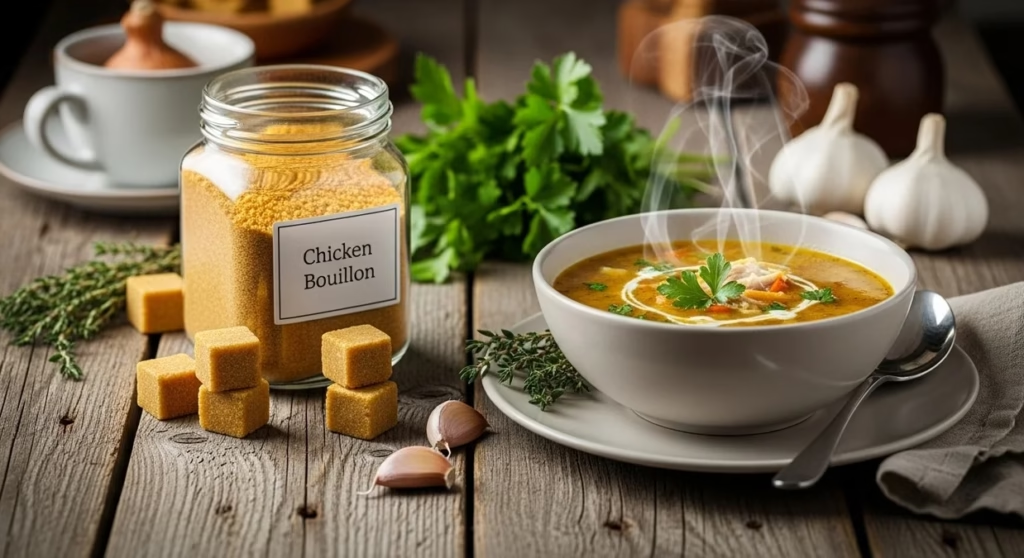Introduction
When it comes to quick flavor boosts in cooking, few ingredients are as versatile as chicken bouillon. From soups and stews to stir-fries and sauces, it has been a kitchen staple for generations. Whether you use bouillon cubes, powdered mix, or concentrated paste, the purpose is the same—bringing deep, savory, and comforting flavor to your meals without hours of simmering bones and vegetables.
In this detailed guide, we’ll explore what chicken bouillon is, its different forms, how to use it, nutrition facts, substitutes, and even some healthy cooking tips.
What is Chicken Bouillon?
Bouillon is a flavoring ingredient made by dehydrating chicken stock or broth into a concentrated form. It usually comes as:
- Bouillon cubes – compressed blocks of seasoning that dissolve in hot water.
- Bouillon powder – fine powder that can be sprinkled directly into dishes.
- Bouillon paste or concentrate – thick gel-like form, often more natural and less salty.
In simple terms, bouillon is like instant chicken broth. Instead of cooking a whole chicken for hours, you just dissolve a cube or spoon of powder in water.
Types of Bouillon
1. Chicken Bouillon Cubes
These small cubes are the most commonly used form worldwide. One cube usually makes about one cup of broth when dissolved in hot water.
✅ Pros: Convenient, long shelf life, budget-friendly
⚠️ Cons: Can be high in sodium and MSG
2. Chicken Bouillon Powder
Powdered bouillon works similarly but offers greater flexibility in measuring. You can sprinkle a little for mild seasoning or use more for a stronger broth flavor.
✅ Pros: Easy to adjust quantity, dissolves quickly
⚠️ Cons: Often contains additives and preservatives
3. Bouillon Concentrate (Paste)
A more premium option, often marketed as “better than cubes.” It contains real chicken fat, seasonings, and fewer artificial ingredients.
✅ Pros: Richer flavor, less processed
⚠️ Cons: More expensive, shorter shelf life after opening
Bouillon vs Chicken Stock
Many people confuse bouillon with stock. While both give flavor, they’re not the same:
| Feature | Bouillon (Powder/Cubes) | Chicken Stock |
|---|---|---|
| Preparation | Dehydrated and processed | Made by simmering bones & vegetables |
| Shelf Life | Long (months/years) | Short (few days if fresh) |
| Flavor | Concentrated, salty, instant | Natural, complex, fresh |
| Use | Quick seasoning or broth base | Gourmet cooking, soups, sauces |
👉 Tip: If you want convenience, go with bouillon. For rich homemade flavor, use stock.
How to Use Bouillon in Cooking
This seasoning mix is incredibly versatile. Here are some common uses:
- Soups & Stews – Add cubes or powder directly to boiling water for instant broth.
- Rice & Grains – Cook rice, quinoa, or couscous with bouillon instead of plain water.
- Marinades – Mix with oil, garlic, and spices for a flavorful chicken marinade.
- Sauces & Gravies – Enhance taste of gravies, stir-fry sauces, or creamy pasta sauces.
- Vegetable Dishes – Boost flavor in sautéed vegetables or mashed potatoes.
💡 Pro Chef Trick: Add a pinch of bouillon powder directly to scrambled eggs or omelets for restaurant-style flavor.
Is Bouillon Healthy?
Bouillon is flavorful, but is it good for you? Let’s look at nutrition facts:
- Calories: Very low (5–20 calories per cube)
- Sodium: High (up to 900 mg per cube = ~40% daily limit)
- Protein: Minimal (not a real protein source)
- Additives: May include MSG, hydrogenated oils, or preservatives
Health Pros
- Convenient way to add flavor
- Low calorie compared to heavy sauces
- Helps picky eaters enjoy vegetables and grains
Health Cons
- High sodium can contribute to high blood pressure
- May contain artificial ingredients
- Not a replacement for real chicken broth nutrition
👉 If you’re health-conscious, choose low-sodium or organic bouillon cubes/powder.
Bouillon Substitutes
If you run out of this seasoning, don’t worry. Here are some great substitutes:
- Homemade Chicken Stock – Best natural replacement
- Vegetable Stock – Lighter option, vegetarian-friendly
- Chicken Base (Better than Bouillon) – Paste concentrate with richer flavor
- Soy Sauce or Tamari – For salty, umami taste
- Miso Paste – Adds savory depth, great in soups
Homemade Bouillon Recipe (Powder Form)
Want a healthier version? You can make your own bouillon powder at home!
Ingredients:
- 1 cup nutritional yeast
- 2 tbsp garlic powder
- 2 tbsp onion powder
- 1 tbsp dried parsley
- 1 tbsp turmeric (for color)
- 2 tsp dried thyme
- 1 tsp celery seed
- 1 tsp salt (optional)
Directions:
- Blend all ingredients into a fine powder.
- Store in an airtight jar.
- Use 1 tablespoon per cup of water for instant broth.
👉 This DIY mix is MSG-free, low-sodium, and 100% natural.
Check Here : Another Greek Chicken Recipe
Popular Brands of Bouillon
Some well-known brands you’ll find globally include:
- Knorr – Widely available, strong flavor
- Maggi – Popular in Asia and Africa
- Better Than Bouillon Chicken Base – Premium, less processed
- Herb-Ox – Sodium-free options available
When shopping, always check the nutrition label for sodium levels and ingredients.
FAQs About Bouillon
1. Is bouillon the same as chicken broth?
Not exactly. Bouillon is concentrated and dehydrated, while broth is fresh liquid made from simmering chicken bones.
2. Can I use bouillon cubes every day?
Yes, but in moderation. Too much sodium can be harmful over time.
3. Does bouillon have real chicken?
Most brands use chicken fat or extracts along with flavor enhancers.
4. Can vegetarians use it?
No, unless it’s a plant-based bouillon designed to mimic chicken flavor.
5. Is bouillon gluten-free?
Some brands are, but not all. Always check packaging.
Final Thoughts
Whether in cubes, powder, or paste, bouillon is a handy kitchen shortcut for adding flavor in seconds. It might not fully replace homemade stock, but its convenience and versatility make it a must-have pantry item.
If you care about health, opt for low-sodium or homemade bouillon to enjoy the flavor without the downsides. From soups to rice, marinades to gravies, this simple seasoning can truly transform your cooking.







